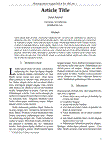| Sumario: | The culture of shrimp is moving, albeit slowly, from an industry dependent on capture of wild animals(broodstock and postlarvae), to the use of domesticated animals. This represents a major shift towards theintensive animal husbandry techniques common in other animal production industries. Although primarilydriven by concerns over the health status of wild stocks, and the consequent impact on farming operations, thisshift also heralds profound implications for shrimp nutrition, not least in the fields of larval and broodstocknutrition. The development of shrimp stocks reared entirely in captivity and potential to develop geneticselection programs raises the possibility of selection based on a number of criteria, including nutrition.Current broodstock maturation systems rely heavily on live feeds as a source of nutrition. Squid, mollusk meats,marine polychaetes and Artemia biomass are among a number of components regarded as important sources ofnutrition for shrimp broodstock. However, natural food items such as these suffer from issues such asavailability and variations in nutritional profile depending on source, season, storage and environmental factors,making it difficult to provide consistent performance. Attempts have been made to produce commercialmaturation diets but impacts on reproductive performance have generally resulted in their use as supplements to,rather than replacements for, live or fresh feeds.Similarly, larval feeding regimes still depend largely on live feed sources such as phytoplankton, rotifers andArtemia. Although generally under greater control in terms of availability and culture conditions, these stillsuffer from some of the problems of consistency as live feeds for broodstock, as well as being relativelyinconvenient and expensive to produce.Many types of formulated larval feeds are available and, in some cases, have been used at high rates ofreplacement for live feeds. However, wide variations in culture conditions and environments, as well asconcerns over quality of post-larvae (as opposed to quantity) produced under high live-feed replacementregimes, have limited widespread adoption of feeding regimes using predominantly formulated diets. At thesame time, there are severe technical constraints to the development of complete feeds for larvae given the smallsize of the feed particles and the development of the larval gut and digestive physiology.This paper will provide a necessarily brief overview of the issues facing feed formulators and some of the keyconsiderations that must be addressed in developing formulated feeds for shrimp broodstock and larvae.
|
|---|
